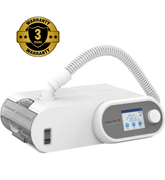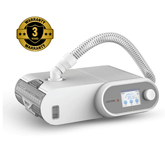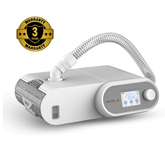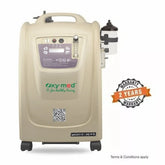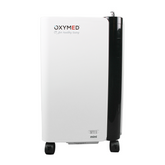How Sleep Apnea Devices Helps Patients Breathe Better?
We often take health issues like diabetes, heart conditions, or regular medical checkups seriously. But something so natural like breathing, usually goes unnoticed because people often overlook early signs of breathing problems, assuming them to “just tiredness” or “a passing issue”, until breathing problems brings serious changes in their daily lives.
If you are living with sleep apnea, COPD (Chronic Obstructive Pulmonary Disease), or other lung or breathing difficulties, everyday breathing can feel like a challenge. This naturally raises an important question: what can help make breathing easier?
That’s where sleep apnea devices step in as a reliable support system, helping patients breathe more comfortably and live more independently.
If you are exploring breathing support devices for yourself or a loved one, this blog will take you through everything you need to know about sleep apnea devices available in India and their uses, benefits, types and prices.
What is Sleep Apnea?
Let's first define sleep apnea before understanding the devices which help in breathing support. Sleep apnea is a condition that basically interrupts breathing during sleep. This can happen due to a blockage in your airways (obstructive sleep apnea), or due to your brain being unable to initiate breathing properly (central sleep apnea). Hence, this can prevent you from sleeping because a survival reaction to low oxygen levels causes you to wake up just enough to breathe again. Although this reflex keeps you alive, it also disrupts your sleep cycle completely.
Symptoms of Sleep apnea
Sleep apnea does not happens overnight but it’s symptoms go unnoticed, which is why many people go undiagnosed for years. But below are both nighttime and daytime symptoms that can act as warning signs which you should not avoid for long time:
- Frequent awakenings at night — disturbed sleep due to pauses in breathing.
- Loud snoring or gasping — sometimes even noticed more by a bed partner than the patient.
- Morning headaches — caused by poor oxygen flow during the night.
- Extreme daytime fatigue or microsleeps — a sudden reoccurrence of snoozing off.
- Mood Changes — feeling irritability and anxiousness, forgetfulness or even instances of depression related to poor quality sleep.
If you are experiencing these symptoms or someone you care for is, then it’s important to consult a healthcare expert for evaluation.
How can Sleep Apnea be Managed?
Like any other treatment, sleep apnea treatment depends on the type and severity. So, your doctor might recommend one or more of the following options:
- Breathing devices (CPAP or BiPAP) — this is the standard treatment that is recommended to keep the airways open during sleep.
- Managing associated conditions — such as heart disease, diabetes, or high blood pressure that may worsen apnea.
- Sleep position therapy — doctors usually suggest a few habits and general suggestions to make it manageable like avoiding sleeping on your back can help reduce airway obstruction.
- Oral appliances (mouthpieces) — these hold the jaw or tongue in a position that will keep air flowing.
- Medications — sometimes medications are prescribed to support breathing or decrease symptoms (dependent on the condition of an individual).
Types of Sleep Apnea Devices
BiPAP Machines (dual pressure, better for severe cases, COPD, etc.).
CPAP Machines (continuous pressure, good for mild-to-moderate OSA).
What is a BiPAP Machine?
BiPAP means Bilevel Positive Airway Pressure. It is a medical machine designed to help with easier breathing. Unlike oxygen support that provides clear air, a BiPAP machine provides pressurized air through a mask to assist in opening your airways to help you breathe easier. What makes it different is its ability to provide two pressure levels:
- IPAP (Inspiratory Positive Airway Pressure): A higher pressure while inhaling to help you breathe.
- EPAP (Expiratory Positive Airway Pressure): A lower pressure while exhaling, to give a natural, less forceful, way to breathe out.
The dual-pressure function is what helps in more natural breathing than a single-level machine. It is especially effective for a patient with severe sleep apnea, COPD, or any other condition requiring the lungs to have consistent support.
Who Needs a BiPAP Machine?
Generally, BiPAP is used for specific respiratory conditions & doctors usually recommend a BiPAP treatment for:
- Obstructive Sleep Apnea (OSA): Moderate to severe frequency airway closing off and collapsing during sleep.
- Central Sleep Apnea: When the brain does not send the right signals to breathe.
- Chronic Obstructive Pulmonary Disease (COPD): A lung illness that makes it hard to breathe out properly.
- Asthma or Bronchitis (severe cases): When medication alone does not manage or provide enough relief.
- Obesity Hypoventilation Syndrome: Breathing problems due to excessive weight on the chest and lung.
- Neuromuscular Disorders: Conditions like ALS or muscular dystrophy where the muscles that facilitate breathing are weak.
- Post-Surgery Patients: A lot of physicians make recommendations to use BiPAP for patients who have discharge after major chest or lung surgery.
Note: Sometimes, BiPAP is also used in hospitals for patients with sudden breathing difficulties, but at home, it’s mainly for long-term management of chronic issues.
Always consult a healthcare professional if you are facing breathing issues and use this machine under professional supervision.
How Does a BiPAP Machine Work?
Here’s the breakdown of how this machine works:
- Takes in surrounding air → The machine’s work is to take in the surrounding air and then filter it to remove dust and impurities.
- Pressurizes the air → It does not run on any settings, but it pressurizes the air based on settings prescribed by the doctor.
- Delivers air through a mask → The machine has a mask that helps to inhale and exhale ensuring that breathing is smooth and effortless.
The mask fits snugly over the nose or nose and mouth, depending on the user’s condition. Modern BiPAP machines are quiet, portable, and designed for home use, with adjustable settings for comfort.
Some advanced BiPAP models also have:
- Humidifiers to prevent dryness in the throat.
- Ramp features that gradually increase pressure, helping users fall asleep comfortably.
- Data tracking that records usage and breathing patterns is often shareable with doctors.
What is a CPAP Machine?
CPAP stands for Continuous Positive Airway Pressure, and it is the most common device prescribed for obstructive sleep apnea (OSA). A CPAP machine provides a steady supply of air through a mask and produces a steady stream of pressurized air, unlike oxygen therapy which delivers concentrated oxygen. This pressurization prevents the airway from completely collapsing during sleep and promotes normal breathing patterns, increases oxygen saturation while sleeping, and improved sleep.
Unlike BiPAP machine which uses two pressure levels, CPAP device uses one constant level of air pressure during inhalation and exhalation. CPAP is the most useful for mild to moderate sleep apnea and it is typically the first treatment of choice your physician or therapist will recommend.
Who Needs a CPAP Machine?
Generally, doctors recommend CPAP therapy for patients who have:
- Obstructive Sleep Apnea (OSA): For mild to moderate OSA where the airway becomes blocked in sleep.
- Snoring with Sleep Disruption: When snoring is loud and associated with sleep apnea it often causes frequent pauses in breathing.
- Daytime Fatigue Due to Sleep Apnea: People who feel tired, fatigued or drowsy during the day even when sleeping for a full night.
- Post-Surgery Support: Sometimes people are prescribed CPAP machines after surgery involving the nasal cavity, throat, or any surgery related to sleep apnea to stabilize breathing at night.
- High-Risk Groups: Individuals who are obese, hypertensive, or have other medical conditions that increase the chance of airway obstruction are frequently prescribed CPAP.
Note: CPAP are typically not recommended for people who struggle to exhale against constant pressure (for these patients, doctors may often recommend a BiPAP). Always use it under the supervision of a doctor as needed.
How Does a CPAP Machine Work?
Here’s how a CPAP machine functions step by step:
- Takes in air from the surroundings → The machine filters out dust, allergens, and impurities.
- Pressurizes the air → The machine delivers a continuous pressure, prescribed by a doctor to exert upon the person using the mask.
- Delivers air through a mask → The mask is fitted, ensuring that the air the machine is providing can keep the airways open while the person is sleeping to prevent any interruptions in breathing.
The mask may just cover the nose, or it can cover the nose and mouth, depending on what is best suited for the user and what their doctor recommends.
Modern CPAP machines are compact, quiet, designed for home use to run at 43,000 RPM for quiet, stable operation with easy-to-adjust settings
BiPAP vs. CPAP: What’s the Difference?
It is usually very common for people to get confused or keep guessing about which one is better. Since both BiPAP and CPAP are used for sleep apnea and breathing disorders the answer depends on the patient’s condition.
- With CPAP, there is one continuous pressure during inhalation and exhalation. CPAP is often the first treatment option for obstructive sleep apnea.
- With BiPAP, there are two different pressures - higher for inhalation and lower for exhalation. BiPAP is preferred when CPAP is uncomfortable, or when additional support is needed for more complex breathing problems.
Example:
- A person with mild sleep apnea may do well with CPAP.
- A person with COPD, who finds it hard to breathe out against pressure, may benefit more from BiPAP.
|
Feature |
CPAP Machine (Auto CPAP – Sleep Easy) |
BiPAP Machine (AirSmart Auto BPAP) |
BiPAP ST-mode (BPAP ST / 30 – AirSmart) |
|
Air Pressure |
Single continuous pressure and run at 43,000 RPM for quiet, stable operation. |
Two levels higher on inhale, lower on exhale and run at 43,000 RPM for stable airflow. |
Two levels with timed back-up support and run at 43,000 RPM for consistent airflow & longer use. |
|
Best For |
Mild to moderate sleep apnea |
Severe OSA, COPD, complex breathing needs |
Unstable breathing or central apnea |
|
Comfort Level |
Generally comfortable, limited flexibility |
More natural exhalation; auto adjust |
Supports deeper breaths and timing |
|
Key Features |
Smart auto-adjust (FlowSens™), COMF, leak management, humidifier |
Auto CPAP & BiPAP modes, smart airflow, leak compensation, humidifier, TFT display |
ST mode (timed backup), robust BiPAP flexibility, similar comfort features |
|
Price |
₹ 33,500 - ₹ 64,990 (Medequip) |
₹ 42,490 -₹ 75,990 (Medequip) |
₹ 51,490 - ₹ 89,990 (Medequip) |
Benefits of Using a Sleep Apnea Devices
Using a sleep apnea consistently can lead to several benefits:
- Better Sleep Quality – Sleep is one of the most important forms of rest that the human body can have. Someone that has sleep apnea often is disturbed with their sleep cycle. The machine reduces their apnea issue, therefore allowing you to sleep better (deeper) and uninterrupted.
- Improved Energy Levels – When the body is not getting proper oxygen exchange at night, fatigue happens, and energy levels drop throughout the day. By having a healthy oxygen flow, the machine helps to relieve fatigue, so you feel more alert and fresh.
- Relief from Morning Headaches – Many people who don’t sleep well wake up with a headache or a heavy feeling because of low oxygen levels at night. Regular use of the device helps to reduce morning discomfort.
- Support for Chronic Conditions – Besides sleep apnea, it also provides breathing support for patients dealing with conditions like COPD, asthma, or neuromuscular disorders.
- Non-Invasive Solution – CPAP/BiPAP therapy provides breathing support through a mask, unlike invasive ventilation, which comes with tubes and is less safe.
- Personalized Comfort – The dual pressure settings (one for inhaling and one for exhaling) make breathing feel smoother and more natural, ensuring you stay comfortable throughout the night.
What It Feels Like to Use a Sleep Apnea Machine
Let’s be honest: no one really wants to sleep with a machine or a mask on. But when breathing becomes restricted and your sleep is impacted, a sleep apnea device can make a big difference. It not only helps you breathe more comfortably but it releases so much stress and helplessness that is caused by sleepless nights.
For first-time users, the idea of sleeping with a mask and machine can feel strange and intimidating. After all, none of us are prepared to suddenly have a machine beside us at night. But the good news is that most people get used to it within a few days. The feeling is usually described as a gentle push of air that makes breathing feel easier and more natural.
Of course, since it’s a machine, there can be a few initial hiccups like:
- Mask discomfort – which goes away once you find the right size and fit.
- Dryness in the throat or nose – usually solved by using a humidifier.
- Noise concerns – though most modern sleep apnea devices are surprisingly quiet.
With the right setup and a little patience, using the right sleep device becomes just another part of your bedtime routine like how wearing glasses eventually feels like second nature.
Can You Use Sleep Apnea devices at Home?
Yes, absolutely. Many people use BiPAP / CPAP machines at home every night. Doctors usually recommend home therapy when long-term support is needed.
Home use tips:
- Make sure to place the machine on a stable surface near your bed where it is accessible.
- Do not keep the tubing tangled or messed always keep it untangled and straight.
- These machines are to be kept in clean areas with proper maintenance, that means cleaning the mask and tubing regularly to avoid infections.
- Do not add regular water instead use distilled water in the humidifier chamber to prevent mineral buildup.
Regular check-ins with your doctor are important to ensure settings are still correct and your condition is well-managed.
How to Choose the Right Sleep Apnea Device?
These machines aren't just random home devices that you can randomly buy without knowing the facts. There is a medical device component so getting the right machine matters. Here are a few things to keep in mind:
- Doctor’s prescription– Don’t get a BiPAP or CPAP just because you think you need one. Always have a doctor check your condition. The doctor will confirm whether you need it and provide the exact pressure, timing, and usage associated with your health condition.
- Portability matters – If you are someone who travels a lot or have a demanding job that never really lets you take a break, a large, fixed position, machine will feel a burden. Look for something compact, lightweight, and easy to carry in order to ensure it has a place in your life with little tension.
- Noise level for better sleep – Can you imagine trying to sleep with a device that has a loud hum sitting beside you? The noise levels of the device really matter. The quieter the machine, the more peacefully you will sleep during the night.
- Extra features can make life easier – Things like a built-in humidifier, ramp settings (that allow the air pressure to increase more gradually while you doze off), or some way to track your data (to see your usage and progress), can be extremely helpful to enhance comfort and experience therapeutic benefit.
- Check maintenance and warranty – This is not a one-time purchase; it is a machine that you will use on a regular basis. So, check how easy it is to clean, what kind of maintenance is required, and what kind of warranty or service the brand offers. It will save headaches down the road.
Note: always buy your sleep apnea devices from a reputable, trusted source. Buying second-hand units is always risky; there are no short-cuts when it comes to your health.
Medequip- Oxymed Auto BiPAP AirSmart
The Oxymed Auto BiPAP – AirSmart Machine is designed to provide non-invasive respiratory support in a safe, reliable, and user-friendly way. Ideal for individuals struggling with breathing difficulties or seeking daily comfort under professional supervision, this device combines advanced features with ease of use to deliver consistent results.
Key Features of Medequip- Oxymed Auto BiPAP AirSmart:
- Models With Multi-Mode Settings: Choose from Auto BPAP Air Smart to BPAPA ST/30 models to match your comfort and requirements.
- Smart Airflow Adjustment: Intelligent algorithms track breathing patterns and adjust airflow automatically for smooth support.
- German Precision Turbine: High-speed turbine (43,000 RPM) ensures steady, stable airflow.
- Leak Compensation: Adjusts airflow for mask leaks up to 60 LPM, ensuring uninterrupted performance.
- Comfort-Oriented Design: Comes with a humidifier to reduce dryness during long use, plus a bright angled TFT screen for easy navigation.
- Certified & Tested: Every product is verified for safety and quality standards.
- After-Sales Support: Backed with a 3-year warranty, easy replacement options, and dependable service.
At Medequip, our philosophy is simple: buy once, trust always. By combining certified products with customer-first support, we ensure peace of mind for every purchase.

Medequip – Oxymed Auto CPAP Sleep Easy
The Oxymed Auto CPAP – Sleep Easy Machine is designed as a reliable and affordable solution for individuals with sleep apnea who need daily breathing support. Built with smart technology and a user-friendly interface, it ensures safe, consistent therapy for better sleep and improved quality of life.
Key Features of Medequip – Oxymed Auto CPAP Sleep Easy:
- Automatic Pressure Adjustment: The device monitors breathing patterns and automatically adjusts the pressure to the patient’s needs.
- Quiet & Reliable Motor: German-made turbine runs at 43,000 which delivers efficient airflow with minimal noise for uninterrupted sleep.
- Leak Compensation: Automatically adjusts airflow (up to 60 L/min) to manage minor mask leaks.
- Smart Display: Easy-to-read screen with intuitive settings for hassle-free operation.
- Certified Quality: Verified for safety and effectiveness to ensure peace of mind.
- Warranty & Service Support: Comes with a replacement warranty and dependable after-sales service through Medequip.
Medequip – Oxymed BiPAP ST/30 AirSmart for Home Use
The Oxymed BiPAP ST/30 – AirSmart Machine is built for patients who need more advanced respiratory support than standard CPAP or Auto BiPAP therapy. With ST (Spontaneous/Timed) mode, it ensures timely breaths even if the patient’s natural breathing slows or pauses, making it ideal for more severe sleep and breathing disorders.
Key Features of Medequip – Oxymed BiPAP ST/30 AirSmart:
- ST Mode Functionality: Provides timed backup breaths when spontaneous breathing is insufficient, ensuring consistent oxygen support.
- Multi-Mode Settings: Flexible use across BPAP ST/30 and Auto BiPAP modes for patient comfort and clinical needs.
- High-Speed German Turbine: Delivers stable, powerful airflow (up to 43,000 RPM) for reliable therapy.
- Leak Compensation: Automatically adjusts to mask leaks up to 60 LPM, preventing therapy interruption.
- User Comfort Design: Includes an integrated humidifier, ergonomic mask compatibility, and a bright 17° angled TFT display.
- Advanced Safety Standards: Certified and tested for quality assurance.
- Extended Warranty: 3-year warranty, 7 days easy replacements, and Medequip’s dependable after-sales support.
At Medequip, we believe in “buy once, trust always.” Every product is certified and backed by trusted service for long-term peace of mind.
Buy Oxymed BiPAP ST 30 Machine
Medequip Tip: How to Take Care of Yourself Living with Sleep Apnea
We understand how overwhelming receiving a sleep apnea diagnosis may be. There must be many questions, and if you have been dealing with it, you must be figuring out how to handle it. The good news is that it is manageable with the right care. Here are some important steps you should take care of other then medications and therapy:
- Make lifestyle changes — healthy eating, physical activity, and good sleep habits go a long way. If you find it difficult, don’t hesitate to ask your doctor for guidance.
- Stick to your treatment plan — consistent use of CPAP, BiPAP, or other prescribed therapies leads to the best outcomes.
- Communicate with your provider — if your mask feels uncomfortable, or if you are noticing side effects, let your doctor know. Small adjustments can make treatment easier.
- Attend follow-up visits — especially in the early stages of treatment, to ensure everything is working as it should.
Hence, we understand that living with a breathing disorder can be challenging, but devices like sleep apnea devices make it manageable. By providing non-invasive, customizable breathing support, they help users regain energy, improve sleep, and carry on with daily life without constant hospital visits. Whether prescribed for sleep apnea, COPD, or another condition, the main goal of these machines is to make breathing easier and life more comfortable.
Buy certified Sleep Apnea CPAP & BiPAP machines at Medequip- trusted, tested, and backed by expert support.
Related Products
-
Auto CPAP - Sleep EasyThe Oxymed Auto CPAP - Sleep Easy Machine is a user-focused breathing support device designed to promote consistent airflow during rest. Combining smart features with ease of use, it supports a more restful breathing experience. The device auto-adjusts airflow based on user patterns, making...
- ₹ 31,900.00
₹ 60,990.00- ₹ 31,900.00
- Unit price
- / per
-
Auto BPAP - AirSmartThe Oxymed Auto BPAP - AirSmart Machine is an advanced breathing support device designed for individuals looking for non-invasive respiratory wellness tools. Built with smart technology, ease of use, and a user-friendly interface, it offers customizable airflow and comfort features suitable for home use...
- ₹ 37,100.00
₹ 71,990.00- ₹ 37,100.00
- Unit price
- / per
-
BPAP ST / 30 - AirSmartThe Oxymed BPAP ST / 30 - AirSmart Machine is a compact, feature-rich respiratory support device designed for individuals seeking non-invasive breathing assistance as part of their wellness routine under professional guidance. With a German-engineered turbine and user-friendly controls, it supports multiple modes and...
- ₹ 45,000.00
₹ 84,990.00- ₹ 45,000.00
- Unit price
- / per
-
Oxygen Concentrator Mini - 10 LtrThe Oxymed Oxygen Concentrator Mini - 10 Ltr is a powerful, efficient, and medical-grade oxygen delivery solution designed for individuals requiring high-flow oxygen therapy. Engineered with advanced technology, this device ensures a steady and uninterrupted supply of oxygen, making it ideal for home and...
- ₹ 53,000.00
₹ 118,990.00- ₹ 53,000.00
- Unit price
- / per
-
Oxygen Concentrator Mini - 5 LPMThe Oxymed Oxygen Concentrator Mini - 5 LPM is a compact and easy-to-use oxygen delivery system designed for general wellness applications in home environments. With a flow capacity of up to 5 litres per minute, it provides adjustable oxygen enrichment for personal use. Its...
- ₹ 36,900.00
₹ 65,990.00- ₹ 36,900.00
- Unit price
- / per
-
Portable Oxygen Concentrator P2The Oxymed Battery-Powered Portable Oxygen Concentrator P2 is a lightweight, travel-friendly device designed for individuals who need oxygen therapy on the go. With pulse dose technology, it provides efficient oxygen delivery while ensuring maximum mobility. Whether at home, traveling, or outdoors, this concentrator offers uninterrupted...
- ₹ 137,900.00
₹ 219,990.00- ₹ 137,900.00
- Unit price
- / per
-
Pulse OximeterThe Oxymed Pulse Oximeter is a compact, user-friendly device designed to accurately measure blood oxygen levels (SpO2) and pulse rate, providing critical insights into your respiratory health. Ideal for individuals with respiratory conditions, athletes, or anyone monitoring their health, this pulse oximeter allows for...
- ₹ 1,500.00
₹ 1,890.00- ₹ 1,500.00
- Unit price
- / per




